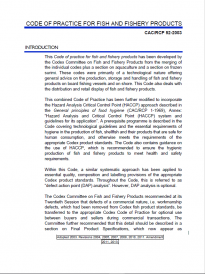Regulatory Environment for On-board Handling in Large Scale Fisheries
Regulatory authorities are responsible for overseeing the implementation of national food law by fishers. Food law should lay out the requirements for good on board handling practices and food safety requirements that minimize the causes of food loss and waste (FLW). Legislation should be supported by food standards and codes of practice that encourage the uptake of good on board handling practice and make the requirements of fishers available in a format understandable by them.
The Codex Alimentarius Code of Practice for Fish and Fishery Products is a reference point for good practice which becomes a legal requirement.
Legislation Related to On-Board Handling of Fish and FLW
Legislation Related to On-Board Handling of Fish and FLW
The European Union has one of the largest markets for fish in the world and fishermen involved in supplying this market, whether they are within the EU or outside it, are obliged to abide by two key pieces of food safety legislation that relate to the on board handling of fish and practices which promote a reduction in FLW:
- Regulation (EC) No 853 / 2004 (Annex III) on specific hygiene rules for animal products
- Regulation (EC) No 852 / 2004 (Annex I) on the hygiene of foodstuffs
These regulations have been used to influence the national legislation in many countries, particularly those exporting fish to the EU market. Key issues in this legislation are:
- Fishing vessels must be designed and constructed so as not cause contamination of fish
- Surfaces with which fishery products come into contact with must be corrosion resistant, smooth, easy to clear and disinfect
- Equipment and materials used for working on fishery product must be made of non-corrosion resistant and easy to clean
- Fish must be chilled as soon as possible
The US is another important market for seafood, and it operates an Imported Seafood Safety Program. The US Food and Drug Administration (FDA) is responsible for the safety of all fish and fishery products entering the United States. The agency uses various tools to identify immediate or potential threats as well as the best course of action to protect public health and safety. As part of the FDA’s import safety effort, the agency provides as much available information and guidance as possible to consumers, industry, and government about seafood safety. Fishing vessels are encouraged to minimize food safety hazards and this leads to practices which will minimize FLW.
Key Publications
Code of Practice for Fish and Fishery Products CAC/RCP 52-200 Global standard that presents information on freezing and cold storage practices which aim to reduce spoilage and waste. |
| |
European Union regulation that guides national requirements related to food temperature and control and food safety in many countries. | ||
European Union regulation that guides national requirements related to handling and hygiene. Annex III Section VIII specifically focuses on fish and fishery products. |
More Resources
More Resources
31 October 2023
01 October 2023













